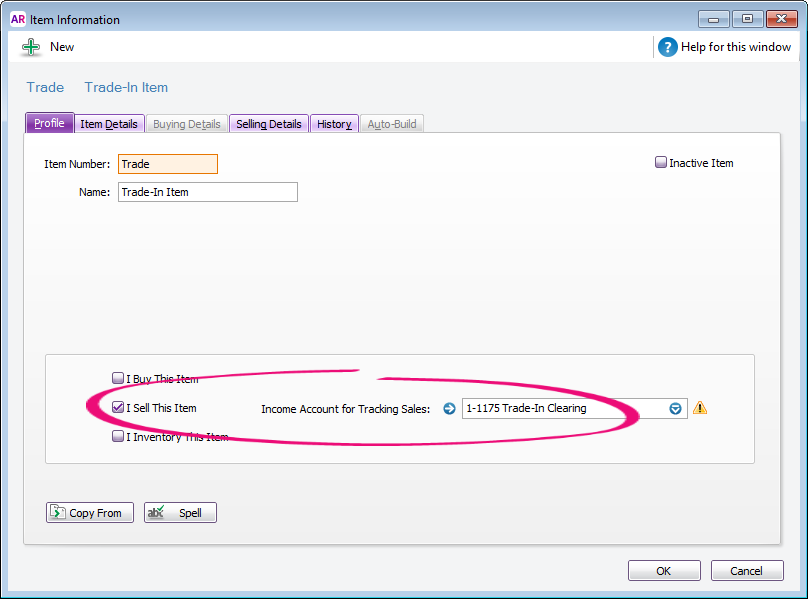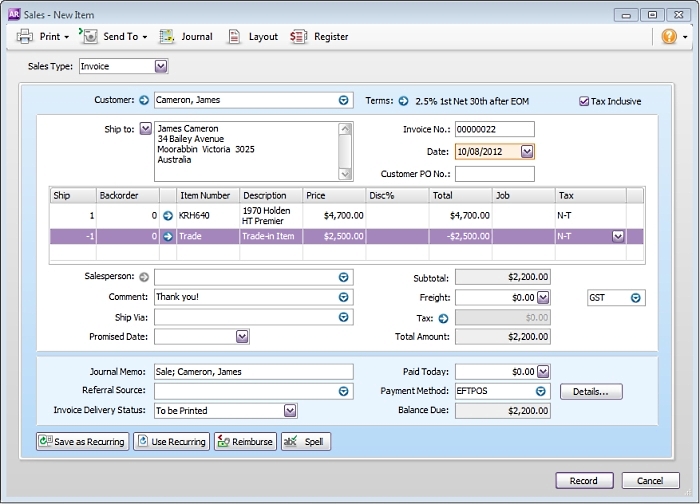- Created by ErikV, last modified by AdrianC on Aug 06, 2015
You are viewing an old version of this page. View the current version.
Compare with Current View Page History
« Previous Version 13 Next »
https://help.myob.com/wiki/x/TouO
How satisfied are you with our online help?*
Just these help pages, not phone support or the product itself
Why did you give this rating?
Anything else you want to tell us about the help?
Does your business accept trade-ins from customers when they purchase a new item? If so, here's how you can set up AccountRight to record these trade-ins and deduct their value from the price of the sale.
The example we'll use is a car dealer who accepts a vehicle trade-in when selling a car, but the same principles can be applied to most trade-in situations. You should also check with your accounting advisor regarding the tax reporting obligations associated with trade-ins for your business.
Before recording a trade-in, there's a couple of things you need to do.
- Create an asset account with the Account Type set to Bank. This account will be used as a clearing account to hold the value of the trade-in.
Here's our example:
- Create an inventory item to represent a default trade-in item. You'll use this item when recording sales to deduct its value from the price of the item being sold.
- Select the option I Sell This Item
- For the Income Account for Tracking Sales, select the asset account created above (ignore the warning about this account usually being an income account)
- On the Selling Details tab, select the relevant Tax/GST Code When Sold.

You're now ready to record sales which include the receipt of traded-in goods.
If the trade-in is from a new customer, create a customer card for them.
You can then enter an invoice to record the transaction.
- On the first line, enter details of the item being sold.
- On the second line:
- enter a negative one (-1) in the Ship field
- select the Trade-In item created earlier
- enter the trade-in value in the Price field

Recording this sale will:
- deduct the value of the trade-in from the sale price, and
- deposit the value of the trade-in into the Trade-in Clearing account (which is the linked account for the Trade-in Item).
When you accept a trade-in, you're effectively buying that item from the customer. So each time you accept a trade-in, complete the following steps to record the purchase.
- Create a supplier card for the customer. This will allow you to select this supplier when recording the purchase.
- Create an inventory item for the trade-in item.
- Select the option I Buy This Item. Depending on what you do with your traded-in items, you can also select I Sell This Item and I Inventory This Item.
- Select the applicable Expense Account for Tracking Costs.
- On the Buying Details tab, select the relevant Tax/GST Code When Bought.

- Enter a bill for the trade-in item.
- Select the supplier card you created for the customer.
- Use the Item layout.
- Select the trade-in item in the Item Number field.
- Enter the trade-in value in the Price field.
Recording this purchase accounts for the receipt of the trade-in item. You can now "pay" for this bill as described in the next task.
The funds that were allocated to the Trade-in Clearing account earlier are used to close the bill.
On the Pay Bills window:
- Select the Pay From Account option and select the Trade-in Clearing account.
- In the Supplier field, choose the supplier card you created for the customer. Their open bill will be listed.
- In the Amount field, enter the trade-in value.
- Apply this amount against the bill.
- Check the transaction details then click Record.
The window below shows a sample of the Pay Bills transaction. This will close the Bill and clear the Trade-in clearing account balance.

 Yes
Yes
 No
No
 Thanks for your feedback.
Thanks for your feedback.